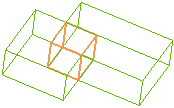



Insert Solid
Solid Boolean
Boolean Union
Union
The Solid Union command joins one or more selected solids to form a single solid.
Two modes are available to perform the Solid Union operation, to be selected in the Boolean drop-down list:
| Global : | It can be applied to any number of solids. The resulting single solid occupies the same space that was previously occupied by the selected solids. |
| Local : | It can be applied only to two solids and enables you to limit the union by selecting some faces, so that the resulting solid will occupy the space obtained by joining the portions of the solids delimited by the selected surfaces. |
To display a preview of the operation, you can select the Preview button ( ).
).
Note that the solids to be joined need not touch or intersect each other. In such instances, the program simply informs you that the resulting object consists of two or more parts and then carries out the operation.
It is possible to retain the original solids after performing the Boolean by using the Keep Original Solids check box available in the command's selection list.

If you apply Solid Union operation on few of the solids of the Multiple Resulting Event (MRE); the solids representation will be grayed out from the Model Structure. In case you perform union operation on all events of the MRE, the all solids will get displayed only under the union node in the Model Structure.